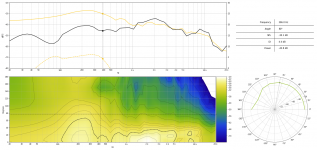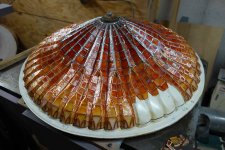Ok, that's good that you have a lead to follow.
Re power response, DI and scaling, the reason I mentioned it is because I am seeing DI go strongly negative regularly (i.e as the magnitude response moves towards and then beneath the power response). The quote I am working from is in
Add directivity index to the multi view * Issue #10 * 3ll3d00d/pypolarmap * GitHub
Basic terminology check first...
pressure response == the magnitude response i.e. abs(output of linToLog for the input data or output of calPolar for the computed data)
Is any scaling required before doing this? The aforementioned quote mentions scaling to 0dB at 1kHz which I am not doing atm
Re power response, DI and scaling, the reason I mentioned it is because I am seeing DI go strongly negative regularly (i.e as the magnitude response moves towards and then beneath the power response). The quote I am working from is in
Add directivity index to the multi view * Issue #10 * 3ll3d00d/pypolarmap * GitHub
Basic terminology check first...
pressure response == the magnitude response i.e. abs(output of linToLog for the input data or output of calPolar for the computed data)
Is any scaling required before doing this? The aforementioned quote mentions scaling to 0dB at 1kHz which I am not doing atm
a release containing the above along with some general improvements to some of the slightly glitchy graphs
Release Polish * 3ll3d00d/pypolarmap * GitHub
Release Polish * 3ll3d00d/pypolarmap * GitHub
is it worth me putting together a canned example in c#?I am unable to find any errors in what I have on this end.
How many frequency points are you using? Your plots look so rough compared to mine.
it uses
Code:
# no of log spaced points to use given a set number of linear points
logPts = {
64: 15,
128: 30,
256: 50,
512: 100,
1024: 200,
2048: 300,
4096: 300
}of course I can change this but there was a discussion earlier in the thread about this, IIRC it boiled down to not using more than 2-300 max and making sure the no of log space points is some fraction of the linear points otherwise things go wrong. Hence it's about 5:1 ratio for most useable window lengths.
there is no interpolation or smoothing on the displayed lines atm either hence the jaggedness
the above came from Klippel Near Field Scanner on a Shoestring
Try dropping the linear points down to 50 is you are only going to use a small number of data points. For 100 you should have 512 data points or more and 200 should have 1024 or more.
....I don't follow "the corrections for near field are done based on a notional source size rather than actually measured"
This is a near field scanner and we need to allow for the fact that the near field does not fall off as 1/r or, equivalently, that the velocity field is not purely radial.
Klippel does measurements at two different radii.
Alternatively we could use only one radius if we measure the velocity field vector with a set of Microflown.
But your software does neither of these, so I assume the near field corrections are done based on the source size that the user nominates.
I don't have your source code to check, of course.
Is that clearer?
I am interested in your idea to do reflection removal if you rotate the speaker rather than the mic.
I don't see how to make it work but it will simplify the mechanics very nicely if you can.
Best wishes
David
I continue to do a little study to understand this better.
Just noticed >Four Audio | ELF<
It has a kind of "robopunk" charm but seems like a hard way to do it.
Move a 100 kg speaker rather than a tiny microphone?
All the anechoic material implies they don't factor out the room modes.
As would be expected if they move the speaker.
(Unless Earl has news on his hopes to do room mode correction even for a movable speaker?)
David
Just noticed >Four Audio | ELF<
It has a kind of "robopunk" charm but seems like a hard way to do it.
Move a 100 kg speaker rather than a tiny microphone?
All the anechoic material implies they don't factor out the room modes.
As would be expected if they move the speaker.
(Unless Earl has news on his hopes to do room mode correction even for a movable speaker?)
David
Last edited:
I continue to do a little study to understand this better.
Just noticed >Four Audio | ELF<
It has a kind of "robopunk" charm but seems like a hard way to do it.
Move a 100 kg speaker rather than a tiny microphone?
All the anechoic material implies they don't factor out the room modes.
As would be expected if they move the speaker.
(Unless Earl has news on his hopes to do room mode correction even for a movable speaker?)
David
Not only the hard way, but also the prohibitively expensive way!
So I know the measurements come from either REW or HolmImpulse, what data is this though? Are they somehow .wav files of the impulse response? Are you directly capturing impulse responses, or are these post-processed based on a sweep?
I'm very interested in this whole project - is there anything that needs doing to help the effort?
Not only the hard way, but also the prohibitively expensive way!
Yes, make no sense to me.
It's the impulse response, but usually not captured directly as the measured response to an impulse.So I know the measurements come from either REW or HolmImpulse, what data is this...?
It's calculated from a more robust technique, Farina swept sine wave is now common, previously MLS (pseudo-random noise) was state of the art.
There are differences in their sensitivity to various artifacts like noise and distortion.
But that is all handled internally by REW, Arta, Holmimpulse or whatever, conceptually for our use it's just an impulse response.
I didn't follow all the details of 3ll3d00d's work with Earl so maybe check with them, in case I have it mistaken.
I'm very interested ...to help the effort?
Others seem to have lost interest, Earl hasn't answered questions for a while.
I continue to have it on the back burner - I need to finish other projects to clear space in my work shop, and in the meantime I learn a little more of the maths.
Also I am about to replace my computer with workstation for FEM/BEM so I should have plenty of power for this task.
Best wishes
David
Last edited:
How one gets the impulse response is not critical, although some methods are better than others, and some programs will output an array of data - as required - and others won't. I built my software around HolmImpulse and it works very well, but any means of getting a single file with the impulse responses at various angles will work.
As to myself, I must apologize for my lagging response. I was gone much of December and still I am having trouble getting back to several tasks that I need to do. As most of you know, or will learn, at 68, one does not have the same breadth of abilities and/or energy level to perform many tasks at the same time. My passion these days is with my glass projects. They are more artistic and less cerebral than these other tasks. That works well for me as I simply do not have the same sharp/quick mind that I once did. When I pull up older code I often can't even figure out what I did. It takes me some time to get back into that gear!
My intention is to get back to this, but my circumstances are not making that easy.
I don't see how FEM/BEM would aid in this task in any way. They are analytic models and this task uses real data to create a model. One has to have an actual device to test, so a model is not of much use. Models are useful when creating a design. Once we have a design the model is no longer of much use.
As to myself, I must apologize for my lagging response. I was gone much of December and still I am having trouble getting back to several tasks that I need to do. As most of you know, or will learn, at 68, one does not have the same breadth of abilities and/or energy level to perform many tasks at the same time. My passion these days is with my glass projects. They are more artistic and less cerebral than these other tasks. That works well for me as I simply do not have the same sharp/quick mind that I once did. When I pull up older code I often can't even figure out what I did. It takes me some time to get back into that gear!
My intention is to get back to this, but my circumstances are not making that easy.
I don't see how FEM/BEM would aid in this task in any way. They are analytic models and this task uses real data to create a model. One has to have an actual device to test, so a model is not of much use. Models are useful when creating a design. Once we have a design the model is no longer of much use.
Attachments
Others seem to have lost interest...
I'm still interested!
But its current programming and math stage feels above my pay-grade to be able to offer much assistance.
As most of you know, or will learn, at 68, one does not have the same breadth of abilities and/or energy level to perform many tasks at the same time. My passion these days is with my glass projects. They are more artistic and less cerebral than these other tasks. That works well for me as I simply do not have the same sharp/quick mind that I once did. When I pull up older code I often can't even figure out what I did.
Good to know I'm not the only one (69 in two weeks).
*waves*Others seem to have lost interest, Earl hasn't answered questions for a while.
I am still here, not much I can do with it atm though
- Home
- Design & Build
- Software Tools
- Klippel Near Field Scanner on a Shoestring

